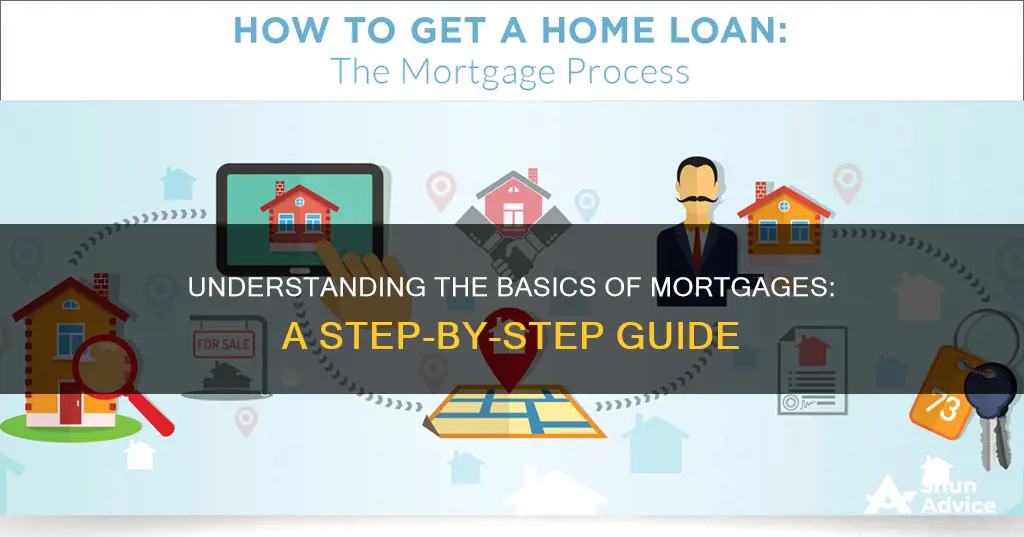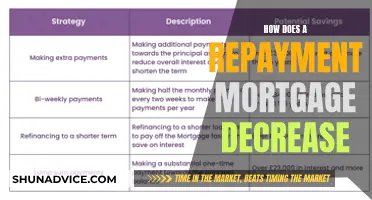
Mortgages are loans used to purchase or maintain real estate, including houses and commercial properties. They are an essential part of home buying for borrowers who cannot afford to buy a property outright. The more you understand how a mortgage works, the better equipped you will be to select the right one for you.
| Characteristics | Values |
|---|---|
| Definition | A mortgage is a loan used to purchase or maintain real estate including houses and commercial properties. |
| Who is it for? | Borrowers who can't afford to pay the entire price of a home upfront. |
| How does it work? | The bank buys the house and gives it to the borrower, who pays them back over a long period of time (e.g. 30 years). |
| What is the monthly payment for? | Principal, interest, taxes, and insurance (PITI). |
| How to get a mortgage? | Check your credit score, compare rates with different lenders, and apply for a mortgage through your preferred lender. |
| Types of mortgages | Conventional, government-backed, adjustable-rate, fixed-rate, jumbo, and Veterans Affairs (VA) loans. |
| Down payment | Typically 20%, but there are programs with lower down payments, such as conventional mortgages (3%) and Federal Housing Administration (FHA) loans (3.5%). |
| Interest rate | Depends on the lender, the borrower's financial health, and market interest rates. |
| Closing costs | Origination fees, discount points, underwriting fees, processing fees, document preparation fees, and funding fees. |

Types of mortgages
A mortgage is a loan used to purchase or maintain real estate, including houses and commercial properties. The borrower agrees to pay the lender over time, typically in a series of regular payments, and the property serves as collateral to secure the loan.
There are several types of mortgages available, each designed for different borrower circumstances. Here are some of the most common types:
- Conventional loans are the most common type of mortgage. They are offered by private banks and come in two forms: conforming and non-conforming loans. Conforming loans meet a set of Federal Housing Finance Agency (FHFA) standards, including guidelines on credit, debt, and loan size. They are eligible to be purchased by government-sponsored enterprises (GSEs) such as Fannie Mae and Freddie Mac. Non-conforming loans, also known as jumbo loans, exceed conforming loan limits and are not backed by GSEs, making them riskier for lenders. They often require a larger minimum down payment, higher closing costs, and a high credit score.
- Government-backed loans are insured by federal agencies and are designed to make homeownership more accessible. These include FHA loans, which are insured by the Federal Housing Administration and require a lower credit score and down payment, and VA loans, which are guaranteed by the US Department of Veterans Affairs for eligible military personnel and their spouses. Government-backed loans often have more favourable requirements, fees, and terms, but there are strict limits on the loan amounts.
- Fixed-rate mortgages offer a stable interest rate and monthly payments throughout the loan term, typically 15 or 30 years. This option provides certainty and is suitable for borrowers who value knowing their long-term loan costs. While the interest rate remains the same, the total monthly payment can still change due to fluctuations in property taxes, insurance, or mortgage insurance.
- Adjustable-rate mortgages (ARMs) have interest rates that can go up or down regularly based on market changes. ARMs offer less predictability but could be cheaper in the short term. They are suitable for borrowers who plan to stay in the property for a short period, prefer lower initial payments, or are comfortable with potential rate increases.
Reporting Mortgage Insurance Premiums: A Comprehensive Guide
You may want to see also

Mortgage applications
A mortgage is a loan used to purchase or maintain a home, plot of land, or other real estate. The borrower agrees to pay the lender over time, typically in a series of regular payments divided into principal and interest. The property then serves as collateral to secure the loan. A borrower must apply for a mortgage through their preferred lender and ensure that they meet several requirements, including minimum credit scores and down payments.
The process of applying for a mortgage can be complicated, but there are a number of distinct steps involved. Most people will go through these six steps: pre-approval, house shopping, mortgage application, loan processing, underwriting, and closing. The process can be long and stressful, so it is important to be patient and not rush it. Check all of your documents carefully, make sure you understand the mortgage terms, and seek expert help if you are unsure about anything.
- Pre-approval: Before starting the mortgage application process, it is a good idea to get pre-approved for a mortgage to know what you can afford. You can do this by providing basic financial information, such as debt, income, and assets, to a lender, who will then give you an estimate of how much you may qualify to borrow.
- House shopping: Once you have a sense of your budget, you can start looking for properties within your price range.
- Mortgage application: After selecting a mortgage lender, fill out the mortgage application and submit all the necessary documents. You will typically receive a loan estimate within a few days disclosing the terms, rates, and fees of your loan.
- Loan processing: At this stage, the lender will review and verify the information provided in your application, including your income, employment, bank deposits, credit report, and property details.
- Underwriting: The underwriter will conduct a rigorous assessment of your application, including ordering an appraisal of the property to determine if the funds from the sale are enough to cover the mortgage amount. They will then decide to accept, reject, or conditionally approve the loan.
- Closing: Before closing, you will receive a Closing Disclosure from your lender, outlining the final terms and costs. Review these documents carefully and ask any questions before finalizing the loan. The closing process can take 30 to 60 days to complete.
It is important to note that the time it takes to get a mortgage can vary depending on factors such as the type of loan, time of year, lender, and specific requirements. Additionally, maintaining a good credit score and managing your debt-to-income ratio can improve your chances of qualifying for a mortgage and obtaining favourable rates.
Exploring Mortgage Records: A Comprehensive Guide to Researching
You may want to see also

Monthly payments
Monthly mortgage payments are typically due on the first of every month. However, unlike rent payments, mortgage payments are paid in arrears, meaning you pay for the previous month. For example, if you closed on your house on the 19th of January, your first mortgage payment would be due on the 1st of March and would cover the month of February.
The amount you borrow with your mortgage is called the principal or the mortgage balance. Each month, part of your monthly payment goes toward paying off the principal, and part pays interest on the loan. Interest is what the lender charges you for lending you money. In the beginning, when your loan balance is high, most of your monthly payment is applied to the interest you owe, and the remainder is used to pay off the principal. Over time, as you pay down the principal, you owe less interest each month, and more of your monthly payment goes towards paying down the principal. This process is known as amortization.
The main factors that determine your monthly mortgage payments are the size and term of the loan. The size of the loan is the amount of money you borrow, and the term is the length of time you have to pay it back. Generally, the longer the term, the lower your monthly payment. This is why 30-year mortgages are the most popular.
Your monthly mortgage payment may also include additional amounts for taxes and insurance. These are often summed up with the term "PITI", an acronym for principal, interest, taxes, and insurance. If you make a down payment of less than 20%, you will also be required to take out private mortgage insurance (PMI), which will increase your monthly payment.
Missouri Mortgage Recording: A Step-by-Step Guide
You may want to see also

Interest rates
Additionally, the type of loan, such as a fixed-rate or adjustable-rate mortgage, impacts the interest rate. With a fixed-rate mortgage, the interest rate remains unchanged for the loan's duration, providing predictable monthly payments. Adjustable-rate mortgages, on the other hand, may offer a lower starting interest rate, but the rate can climb higher over time, depending on market fluctuations.
Mortgage interest rates are subject to economic forces and market trends. Factors such as inflation, changes in the housing market, monetary policies set by central banks, and broader economic cycles all contribute to the dynamic nature of interest rates. For instance, during economic downturns or recessions, interest rates tend to decrease as central banks stimulate borrowing and spending. Conversely, job growth and a strong economy are typically associated with higher interest rates.
It is worth noting that interest rates can significantly impact the affordability of a home. A slight increase in the interest rate can lead to higher monthly payments, while a lower interest rate can make homeownership more accessible. Therefore, it is essential to compare rates from multiple lenders and consider the potential impact on long-term costs.
Moreover, the loan term also influences the interest rate. Shorter-term loans, such as those with a duration of 10, 15, or 20 years, generally have lower total interest costs over time, despite requiring larger monthly payments. In contrast, longer-term loans, such as 30-year mortgages, offer more manageable monthly payments but accumulate higher interest costs in the long run.
Cosigner Impact: Mortgage Approval and Beyond
You may want to see also

Foreclosure
Mortgages are a crucial aspect of purchasing a home, as they allow buyers to secure financing for properties they may not be able to afford outright. However, if a borrower defaults on their mortgage payments, they may face foreclosure. Foreclosure is the legal process by which a lender can take ownership of a mortgaged property and sell it to recoup their losses. This typically occurs when a borrower fails to make timely payments, and the lender exercises their rights under the acceleration clause in the mortgage contract.
There are two types of foreclosure processes: judicial and non-judicial. Judicial foreclosure requires the lender to obtain a court order before taking possession of the property, while non-judicial foreclosure allows the lender to take back the property without court involvement. The type of foreclosure process that can be used depends on the state of residence. During the pre-foreclosure period, which is typically 120 days, lenders are required to provide "loss mitigation" options, such as alternative repayment plans, to help borrowers resolve their financial situation with minimal damage to their credit score.
If a borrower cannot resolve their payment issues, the lender will initiate the foreclosure process and repossess the property. The property is then usually sold at a public auction, and if it is not sold, the lender will retain possession and resell it through a regular real estate sale. The proceeds from the sale are used to repay the borrower's outstanding debt. Any remaining balance after the sale is typically the borrower's responsibility, although this varies by state.
Understanding Mortgage and Title Linkage
You may want to see also
Frequently asked questions
A mortgage is a loan used to purchase or maintain a home, plot of land, or other real estate. The borrower agrees to pay the lender over time, typically in a series of regular payments. The property then serves as collateral to secure the loan.
Before applying for a mortgage, it is important to do some prep work. Check your credit score and take a look at your credit report to ensure there are no inaccuracies. Mortgage lenders will be checking both of these to determine your future interest rate. Once you feel your credit score is in good enough shape, start thinking about the type of mortgage you're looking for. You can then start shopping around for mortgage loans by getting details and terms from several lenders or mortgage brokers.
After your mortgage application has been approved, compare offers for rates and fees from each lender and choose the one you want to go with. The loan processing stage will then begin, where your lender will review your application and may ask for additional documents such as tax forms, pay stubs, bank statements, and employer contact information.







